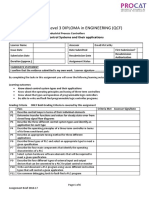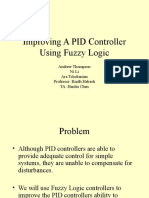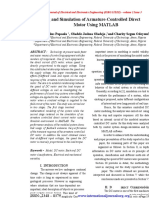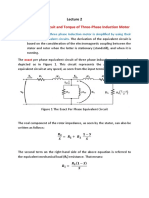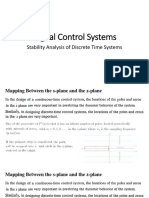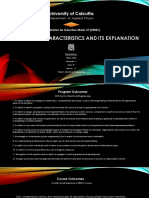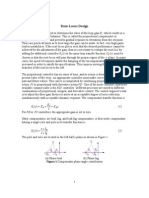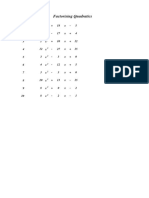Control Lecture 8 Poles Performance and Stability
Uploaded by
Sabine BroschControl Lecture 8 Poles Performance and Stability
Uploaded by
Sabine BroschLecture 7: Poles, system
performance and system stability
Zeros: All the values of s for which n(s) = 0
G s
n s
d s
b s b s b s b
a s a s a s a
m
m
m
m
n
n
n
n
( )
( )
( )
= =
+ + + +
+ + + +
1
1
1
1
0
1
1
1
1
0
Poles: All the values of s for which d(s) = 0
When the system G(s) has more than one pole or one zero at the
same co-ordinates on the s-plane, we say that G(s) has multiple
poles or multiple zeros.
0.4
0.6
0.8
1
0
0.5
1
s
1
s
2
s
3
s
4
First
Order
System
Time
30 40
0
0.2
0.4
Real Axis
-1 -0.5 0 0.5 1
-1
-0.5
4
Step Response
Pole-zero map
System
0
1
2
p
1
R
-
n
-
n
1-
2
n
1-
2
C
O
Second Order
System
Real Axis
Pole-zero map
-1.5 -1 -0.5 0 0.5 1
-2
-1
-
n
1-
p
2
Second Order Systems:
For 0 < < 1,
G s
s s
n
n n
( ) =
+ +
2
2 2
2
Pole-zero map
-4
-3
-2
-1
0
1
2
3
4
Lines of constant
damping ratio,
Semicircles
of constant
( )
( )
2
1
2
1
1
n n
p j
p j
= +
=
The angle OCP
1
is tan = ? and R
2
=
n
2
Therefore all poles with constant value for
n-
will lie on a semi-circle,
radius R(=
n
) from the origin.
For different values of , we find a number of straight lines making
different angles with the real axis. We can then easily establish a
relationship between the location of poles and and
n
. This is shown
here.
Real Axis
-4 -3 -2 -1 0 1
-5
-4
n
( )
2
2
1
n n
p j =
Step response performance measures
overshoot
rise time
peak time
settling time
Step response
Complex conjugate poles,
underdamped system:
( )
2
1
( ) 1 sin 1 ( )
n
t
n
y t K e t t
| |
= +
|
|
1
2
1
1
tan
| |
= |
|
2
2
1
( ) ( ) ( )
1 2
1
n n
K
Y s G s U s
s
s s
= =
+ +
( )
2
( ) 1 sin 1 ( )
1
n
n
y t K e t t
= +
|
|
\
1 tan
= |
|
\
Amplitude (steady-state value): K
Rise time: from the equation above find the smallest t such that y(t)=K
(a numerical solution is required)
90% Rise time: from the equation above find the smallest t such that
y(t)=0.9K (also suitable for overdamped systems, a numerical
solution is required)
Peak time: from the equation above find the smallest t such that:
( )
0
dy t
dt
=
Step response performance measures
overshoot
2
1
p
n
T
=
Peak time:
Peak value:
( )
2
/ 1
( ) 1
p
y T K e
= +
4
0.02
n s
T
s
n
e T
=
( )
( ) 1
p
y T K e = +
2% Settling time: find time T
s
such that after this time the amplitude
is within 2% of the steady-state value
Higher order systems
( ) ( ) ( )
1 2
1 2 1 2
( )
m
m m
B K B B
G s
s s s s s s s s s s s s
= = + + +
Partial fraction decomposition of the transfer function:
G(s) G(s)
Dominant pole of the transfer function: lowest absolute
value, i.e. closest to zero. Produces the slowest response
What do we mean by bounded signals? A time domain
signal, x(t), is assessed by the behaviour of its magnitude
over an infinite time interval. As time tends to infinity,
the absolute value of the signal magnitude can either:
continuously decrease and/or increase, (or stay constant)
but remain within a bounded range.
Decaying exponential signals have Laplace transforms with poles in
the LHP.
Growing or increasing exponential signals have Laplace transforms
with poles in the RHP.
We can generalise this observation as follows:
Poles in LHP and RHP: Signals whose transforms have all the poles Poles in LHP and RHP: Signals whose transforms have all the poles
in the LHP are bounded. Signals whose transforms have any one pole
in the RHP are unbounded.
Poles on j axis: Signals whose transforms have poles in the LHP
and no multiple poles on the j axis are bounded, otherwise they are
unbounded.
What is a stable system?
We call a system stable if its output signal is bounded for any
bounded input signal. We call this type of system stability
bounded-input bounded-output stability.
Stability Test: A system is stable if all its poles lie in the Left Stability Test: A system is stable if all its poles lie in the Left
Half Plane.
M Using MATLAB to check the stability of a system
Enter the System transfer function using: s = tf(s); g = ..
then either run: pzmap(g). If all the poles are located in
the LHP the system is stable. Otherwise the system is unstable.
Open loop system:
transfer function analysis:
The open-loop transfer function:
K(s) G(s)
R(s)
U(s) Y(s)
( ) ( )
( ) ( ) ( )
( ) ( )
G K
ol
G K
n s n s
G s G s K s
d s d s
= =
( ) ( )
( ) , K(s)
( ) ( )
G K
G K
n s n s
G s
d s d s
= =
Characteristic equation of the system: find the poles of the
transfer function.
Open loop poles are the roots of :
d
OL
(s) = d
K
(s)d
G
(s) = 0
( ) ( )
G K
d s d s
Unity feedback system
transfer function analysis:
K(s) G(s)
+
-
R(s)
U(s) Y(s)
( ) ( )
( ) , K(s)
( ) ( )
G K
G K
n s n s
G s
d s d s
= =
The closed-loop transfer function:
Characteristic equation of the system: find the poles of the
transfer function.
Closed loop poles are the roots of :
d
CL
(s) = d
K
(s)d
G
(s) + n
K
(s)n
G
(s) = 0
( ) ( ) ( ) ( )
( )
1 ( ) ( ) ( ) ( ) ( ) ( )
G K
cl
G K G K
n s n s G s K s
G s
G s K s d s d s n s n s
= =
+ +
Stability necessary condition
( ) 0
1 ( ) ( ) 0
( ) ( ) ( ) ( ) 0
G K G K
ChE s
G s K s
d s d s n s n s
=
+ =
+ =
Characteristic equation (closed loop system):
1 2 2
1 2 2 1 0
... 0
n n n
n n n
c s c s c s c s c s c
+ + + + + + =
n-th order system
1 2 2 1 0
1 0
2
2 1 0
3 2
3 2 1 0
... 0
0
0
0
n n n
c s c s c s c s c s c
c s c
c s c s c
c s c s c s c
+ + + + + + =
+ =
+ + =
+ + + =
First order system
Second order system
Third order system
Necessary condition for stability is that all coefficients in the Characteristic
Equation have the same sign (i.e. either positive or negative).
Stability, Hurwitz-Ruth criterion
1 2 2
1 2 2 1 0
... 0
n n n
n n n
c s c s c s c s c s c
+ + + + + + =
Assume that the Characteristic Equation is n-th order polynomial:
Build a matrix as follows: 1 3 5
2 4
1 3 5
0
0
0 0
n n n
n n n
n n n
c c c
c c c
c c c
M
(
(
(
(
=
(
2 4
0
0
0
n n n
M
c c c
c
=
(
(
(
(
(
Calculate determinant of M and of all sub-matrices obtained by
cutting the last k rows and columns of M.
If all are positive, and c
n
is positive, the system is stable.
Stability, Hurwitz-Ruth criterion, examples
1 0
2
2 1 0
3 2
3 2 1 0
4 3 2
4 3 2 1 0
0
0
0
0
c s c
c s c s c
c s c s c s c
c s c s c s c s c
+ =
+ + =
+ + + =
+ + + + =
First order system
Second order system
Third order system
4-th order system
0
M c =
First order system For First order system and
1
1 0
2 0
0
, 0
c
M c c
c c
(
= >
(
2 0
3 1 2 1 3 0
2 0
0
0 , 0
0
c c
M c c c c c c
c c
(
(
= >
(
(
( )
3 1
3 2 4 1
4 2 0
3 1
2
1 3 2 4 1 0 3
4 2 0
0 0
0
0
,
0 0
0
0
c c
c c c c
c c c
M and
c c
c c c c c c c
c c c
(
>
(
(
=
(
> (
Second order system
Third order system
4-th order system
Second order system
necessary condition is also
sufficient condition.
Examples
K(s) G(s)
+
-
R(s)
U(s) Y(s)
Use SIMULINK to simulate the step responses of the systems
with transfer functions selected as below. Which combinations can
lead to unstable systems?
( )
p
I
p
I
p D
k
k
K s k
s
k
k k s
s
= +
+ +
2
2
1
1
1
( )
1 2
1
1
n n
s
K
sT
K
sT s
G s
K
s s
K
e
sT
+ +
+
lead to unstable systems?
Fast pump Slow pump
Inflow
How do the zeros of a transfer function model arise?
Zeros arise from the internal physical pathways of a process and
represent where these internal effects are adding together or
competing(subtracting ) with one another.
Example: The feeder tank is used to supply a steady flow of liquid
feed to downstream processes.
Outflow
Feeder Tank
Inflow
Unit
Voltage Step
Level
Inflow
5s+1
1
Slow pump
0.833
10s+1
Feeder Tank
0.75s+1
0.5
Fast pump
Poles, zeros and stability
Poles and time responses for first order and
second order systems
Stability and its link to location of poles of Stability and its link to location of poles of
transfer function
You might also like
- Ebooks File Cambridge Essential English Dictionary 2nd Edition Cambridge University Press All Chapters100% (3)Ebooks File Cambridge Essential English Dictionary 2nd Edition Cambridge University Press All Chapters78 pages
- Unit I - Discrete State-Variable Technique Q.No Questions: Scalar Adder IntegratorNo ratings yetUnit I - Discrete State-Variable Technique Q.No Questions: Scalar Adder Integrator184 pages
- Cs Project Report: Comparative Analysis of P, I, D, PI, PD, PID On Speed Control of DC Motor Using MATLAB SimulinkNo ratings yetCs Project Report: Comparative Analysis of P, I, D, PI, PD, PID On Speed Control of DC Motor Using MATLAB Simulink25 pages
- PID Control Design Made Easy: News&NotesNo ratings yetPID Control Design Made Easy: News&Notes4 pages
- BTEC Unit 50 - Assignment 1 (P1, P2, P3)No ratings yetBTEC Unit 50 - Assignment 1 (P1, P2, P3)6 pages
- Understanding Pole-Zero Plots On The S PlaneNo ratings yetUnderstanding Pole-Zero Plots On The S Plane7 pages
- Lecture-9 Time Domain Analysis of 1st Order SystemsNo ratings yetLecture-9 Time Domain Analysis of 1st Order Systems27 pages
- Improving A PID Controller Using Fuzzy LogicNo ratings yetImproving A PID Controller Using Fuzzy Logic29 pages
- Lecture 12-13 Time Domain Analysis of 1st Order SystemsNo ratings yetLecture 12-13 Time Domain Analysis of 1st Order Systems56 pages
- Design Via Root Locus and Frequency ResponseNo ratings yetDesign Via Root Locus and Frequency Response15 pages
- Modelling and Simulation of Armature-Controlled Direct Current Motor Using MATLABNo ratings yetModelling and Simulation of Armature-Controlled Direct Current Motor Using MATLAB7 pages
- Linear Variable Differential Transformer LVDTNo ratings yetLinear Variable Differential Transformer LVDT8 pages
- Electrical Machines : Torque of Induction MotorNo ratings yetElectrical Machines : Torque of Induction Motor12 pages
- The Equivalent Circuit and Torque of Three-Phase Induction MotorNo ratings yetThe Equivalent Circuit and Torque of Three-Phase Induction Motor11 pages
- Higher National Diploma in Engineering: Assessment BriefNo ratings yetHigher National Diploma in Engineering: Assessment Brief22 pages
- Digital Control Systems: Stability Analysis of Discrete Time Systems100% (1)Digital Control Systems: Stability Analysis of Discrete Time Systems33 pages
- Torque-Slip Characteristics and Its ExplanationNo ratings yetTorque-Slip Characteristics and Its Explanation17 pages
- Control Tutorials For MATLAB and Simulink - Introduction - PID Controller DesignNo ratings yetControl Tutorials For MATLAB and Simulink - Introduction - PID Controller Design17 pages
- B - Lecture9 Examples of Steady-State Error Automatic Control System100% (1)B - Lecture9 Examples of Steady-State Error Automatic Control System3 pages
- Direct Current Rotational Mechanical Energy: Transfer Function of The DC MotorNo ratings yetDirect Current Rotational Mechanical Energy: Transfer Function of The DC Motor5 pages
- WEEK 4 MODULE 4 Control System Analysis by Frequency Response MethodNo ratings yetWEEK 4 MODULE 4 Control System Analysis by Frequency Response Method96 pages
- Thyristor Based Speed Control of DC and Ac Motor100% (1)Thyristor Based Speed Control of DC and Ac Motor14 pages
- Stability and Steady-State Response Analyzes: Lectures 21-24No ratings yetStability and Steady-State Response Analyzes: Lectures 21-2451 pages
- Simulation of Some Power System, Control System and Power Electronics Case Studies Using Matlab and PowerWorld SimulatorFrom EverandSimulation of Some Power System, Control System and Power Electronics Case Studies Using Matlab and PowerWorld SimulatorNo ratings yet
- Lecture 5-Poles, Zeros and System StabilityNo ratings yetLecture 5-Poles, Zeros and System Stability23 pages
- Student Solutions Manual to Accompany Economic Dynamics in Discrete Time, secondeditionFrom EverandStudent Solutions Manual to Accompany Economic Dynamics in Discrete Time, secondedition4.5/5 (2)
- AU2120 Automotive Systems Engineering 1 PDFNo ratings yetAU2120 Automotive Systems Engineering 1 PDF6 pages
- Thin Aerofoil Theory: AE3010 Aerodynamics Lecture 2No ratings yetThin Aerofoil Theory: AE3010 Aerodynamics Lecture 259 pages
- AE3010 Aerodynamics and Propulsion: Dr. Peter Barrington RV219 P.barrington@kingston - Ac.ukNo ratings yetAE3010 Aerodynamics and Propulsion: Dr. Peter Barrington RV219 P.barrington@kingston - Ac.uk55 pages
- Lecture 2 V-N Diagram and Gust Diagram (Compatibility Mode)67% (3)Lecture 2 V-N Diagram and Gust Diagram (Compatibility Mode)21 pages
- ECG353-chapter 2 - Vertical Stress Distribution - Part 2No ratings yetECG353-chapter 2 - Vertical Stress Distribution - Part 221 pages
- GR 9 Final Assessment Datesheet and SyllabusNo ratings yetGR 9 Final Assessment Datesheet and Syllabus7 pages
- St. Bernard Parish Gov't v. United States, No. 05-1119L (Fed. Cl. May 1, 2015)100% (1)St. Bernard Parish Gov't v. United States, No. 05-1119L (Fed. Cl. May 1, 2015)74 pages
- DBM CSC Form No. 1 Position Description Forms BlankNo ratings yetDBM CSC Form No. 1 Position Description Forms Blank1 page
- Concentration and Attention: Playful LearningNo ratings yetConcentration and Attention: Playful Learning21 pages
- PCB (Printed Circuit Board) Layout and EMI (Electromagnetic I..100% (3)PCB (Printed Circuit Board) Layout and EMI (Electromagnetic I..2 pages
- Contemporary Philippine Arts IntroductionNo ratings yetContemporary Philippine Arts Introduction16 pages
- On The Method of Ship's Transoceanic Route PlanningNo ratings yetOn The Method of Ship's Transoceanic Route Planning8 pages
- Yu Hua - On Brothers and Chaotic Aesthetics, (Chinese Literature Today, Spring 2011)No ratings yetYu Hua - On Brothers and Chaotic Aesthetics, (Chinese Literature Today, Spring 2011)6 pages
- Applications of Thin Airfoil Theory - Part 1No ratings yetApplications of Thin Airfoil Theory - Part 128 pages
- Ebooks File Cambridge Essential English Dictionary 2nd Edition Cambridge University Press All ChaptersEbooks File Cambridge Essential English Dictionary 2nd Edition Cambridge University Press All Chapters
- Unit I - Discrete State-Variable Technique Q.No Questions: Scalar Adder IntegratorUnit I - Discrete State-Variable Technique Q.No Questions: Scalar Adder Integrator
- Cs Project Report: Comparative Analysis of P, I, D, PI, PD, PID On Speed Control of DC Motor Using MATLAB SimulinkCs Project Report: Comparative Analysis of P, I, D, PI, PD, PID On Speed Control of DC Motor Using MATLAB Simulink
- Lecture-9 Time Domain Analysis of 1st Order SystemsLecture-9 Time Domain Analysis of 1st Order Systems
- Lecture 12-13 Time Domain Analysis of 1st Order SystemsLecture 12-13 Time Domain Analysis of 1st Order Systems
- Modelling and Simulation of Armature-Controlled Direct Current Motor Using MATLABModelling and Simulation of Armature-Controlled Direct Current Motor Using MATLAB
- The Equivalent Circuit and Torque of Three-Phase Induction MotorThe Equivalent Circuit and Torque of Three-Phase Induction Motor
- Higher National Diploma in Engineering: Assessment BriefHigher National Diploma in Engineering: Assessment Brief
- Digital Control Systems: Stability Analysis of Discrete Time SystemsDigital Control Systems: Stability Analysis of Discrete Time Systems
- Control Tutorials For MATLAB and Simulink - Introduction - PID Controller DesignControl Tutorials For MATLAB and Simulink - Introduction - PID Controller Design
- B - Lecture9 Examples of Steady-State Error Automatic Control SystemB - Lecture9 Examples of Steady-State Error Automatic Control System
- Direct Current Rotational Mechanical Energy: Transfer Function of The DC MotorDirect Current Rotational Mechanical Energy: Transfer Function of The DC Motor
- WEEK 4 MODULE 4 Control System Analysis by Frequency Response MethodWEEK 4 MODULE 4 Control System Analysis by Frequency Response Method
- Stability and Steady-State Response Analyzes: Lectures 21-24Stability and Steady-State Response Analyzes: Lectures 21-24
- Simulation of Some Power System, Control System and Power Electronics Case Studies Using Matlab and PowerWorld SimulatorFrom EverandSimulation of Some Power System, Control System and Power Electronics Case Studies Using Matlab and PowerWorld Simulator
- Student Solutions Manual to Accompany Economic Dynamics in Discrete Time, secondeditionFrom EverandStudent Solutions Manual to Accompany Economic Dynamics in Discrete Time, secondedition
- Thin Aerofoil Theory: AE3010 Aerodynamics Lecture 2Thin Aerofoil Theory: AE3010 Aerodynamics Lecture 2
- AE3010 Aerodynamics and Propulsion: Dr. Peter Barrington RV219 P.barrington@kingston - Ac.ukAE3010 Aerodynamics and Propulsion: Dr. Peter Barrington RV219 P.barrington@kingston - Ac.uk
- Lecture 2 V-N Diagram and Gust Diagram (Compatibility Mode)Lecture 2 V-N Diagram and Gust Diagram (Compatibility Mode)
- ECG353-chapter 2 - Vertical Stress Distribution - Part 2ECG353-chapter 2 - Vertical Stress Distribution - Part 2
- St. Bernard Parish Gov't v. United States, No. 05-1119L (Fed. Cl. May 1, 2015)St. Bernard Parish Gov't v. United States, No. 05-1119L (Fed. Cl. May 1, 2015)
- DBM CSC Form No. 1 Position Description Forms BlankDBM CSC Form No. 1 Position Description Forms Blank
- PCB (Printed Circuit Board) Layout and EMI (Electromagnetic I..PCB (Printed Circuit Board) Layout and EMI (Electromagnetic I..
- On The Method of Ship's Transoceanic Route PlanningOn The Method of Ship's Transoceanic Route Planning
- Yu Hua - On Brothers and Chaotic Aesthetics, (Chinese Literature Today, Spring 2011)Yu Hua - On Brothers and Chaotic Aesthetics, (Chinese Literature Today, Spring 2011)










